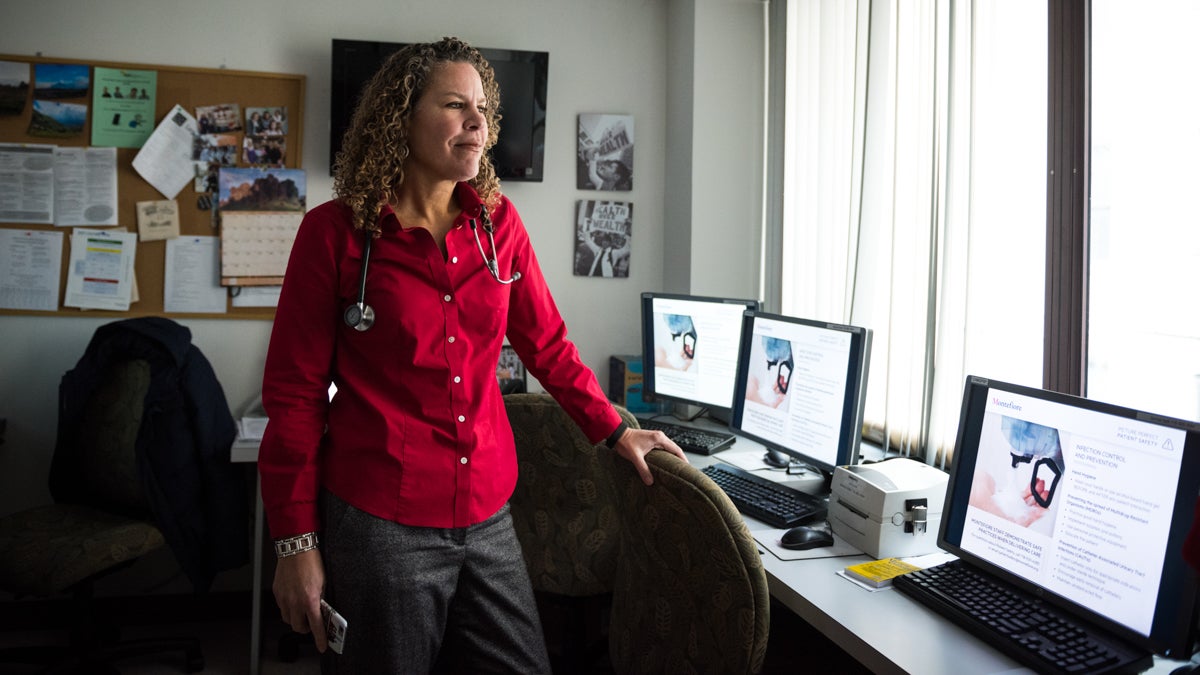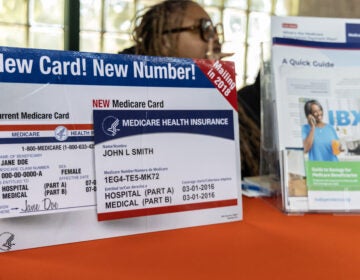Stigma keeps some doctors from treating drug addiction
Listen
Dr. Cunningham poses for a portrait in her office at the Montefiore Comprehensive Care Center in the Bronx. (Edwin Torres/GroundTruth)
Most primary care doctors aren’t able to prescribe Rx anti-addiction medicine.
Internal medicine physician Chinazo Cunningham runs a family health center in New York’s South Bronx.
She has an appointment with Dinah, one of her regular patients. This is a routine checkup but a bit different — Dinah is a recovering heroin user. She takes buprenorphine, a prescription medication that treats her addiction and prevents relapse. Cunningham prescribes Dinah this drug and all of her other medications during her quarterly visits to the health center.
“It is a one-stop shop and the treatment that I get here is phenomenal,” said Dinah, who asked that I only use her first name.
Dinah, 43, is chatty with a bright smile and youthful brown face. She looks younger than her age with her black hair weaved into two long braids. Dinah grew up in the South Bronx and when she was 13 years old, her mom died from cancer. To cope with the loss, she eventually started using cocaine. Then, in her mid-20s, Dinah tried heroin.
“Then I started feeling really, really good,” she said. “I was like you know I want to do this again and so I did.”
Dinah continued to use heroin for the next decade. During this time, she was in and out of prison and jail — a pattern that’s familiar to many people with a serious substance abuse problem.
For a very long time, the country largely dealt with addiction as a criminal problem. From 2000 to 2010, the number of people in prison for drug offenses grew by more than 30 percent. While drug users have always been mostly white, blacks and Hispanics are incarcerated at a much higher rate.
“So in the Bronx, this is not new at all. I mean this has been going on for decades,” Cunningham said. “Nobody really cared and felt the need to really address this.”
Soon, the number of people abusing prescription pills skyrocketed and the opioid epidemic tore through America’s heartland including lots of places outside big cities. As more young, white and wealthy people got hooked on opioids and then heroin, more people began to pay attention to addiction experts like Cunningham.
“Ten years ago, we were all about incarcerating people,” she said.
There’s been a shift in how drug offenders are treated and the number of incarcerations across the United States has declined. Increasingly, courts prefer to send people to treatment programs. The first drug court opened in 1989 and now there are more than 3,000 across the country.
“Now we are discussing that addiction is a chronic illness. That addiction is a medical problem. That addiction requires medical treatment,” Cunningham said.
Addiction experts want to treat opioid dependence like heart disease, asthma or other lifelong conditions. Research has found that one of the most effective ways to do this is with prescription medication like methadone or buprenorphine. These drugs help reduce withdrawal or cravings and maintain recovery. The treatment approach works best when it’s paired with counseling and long-term care. Cunningham said her clinic at the Montefiore Comprehensive Health Care Center does all of that.
“And so patients come to us for their diabetes and their high blood pressure and their addiction and their depression. And we will provide treatment for all of those things and then if people need specialty care, we might send them to a psychiatrist or to somebody with an addiction specialty.”
More than a decade ago, Cunningham’s clinic was one of the first health centers in the country to integrate addiction treatment with primary care. While anti-addiction medications work very well for many people in recovery, many doctors don’t want to prescribe them.
“Some of the barriers that we have heard is that, I don’t want quote, unquote, ‘those patients in our waiting room.’ My response is, quote, unquote, ‘those patients are already in your waiting room,'” Cunningham said. “They are your colleagues, your patients, your neighbors, your friends and your family members because addiction does not discriminate.”
Right now only about three percent of primary care doctors nationwide have the required license from the Drug Enforcement Agency.
Cunningham says one of the reasons is stigma.
Cunningham has worked in this South Bronx community for 19 years. Every month she holds a meeting to train doctors, pharmacists and other health care providers on new ways to treat addiction. The group has discussed a variety of topics including how to treat pregnant women who take buprenorphine. This is just one of the many new issues that will need to be addressed as more providers start prescribing anti-addiction drugs.
“Most doctors haven’t had the training in medical school or residency,” Cunningham said. “And so this is a way for providers to feel you know, when they have cases, when they have questions, that they can go to this meeting and really think about how to best provide treatment.”
Over the years, officials have tried many things in an effort to narrow the treatment gap. In 2014, the Affordable Care Act mandated that all insurance companies cover mental health and substance use disorder services in the same way they were covering other health problems. There is also now a federal law that allows nurses and physicians assistants to also be licensed to prescribe opioid addiction medication.
Cunningham said it will take more people, thinking differently about addiction, to curb the epidemic.
“It takes a lot of work to change the culture. It’s not just the doctors, it’s the nurses, it’s the front, you know, desk staff, it’s everybody throughout the system. It’s administrators to say this is what we do, this is part of the care we provide.”
Editor’s note: This story comes to us from The GroundTruth Project. You can hear more of Stephanie Daniel’s reporting in the latest season of GroundTruth podcast.
WHYY is your source for fact-based, in-depth journalism and information. As a nonprofit organization, we rely on financial support from readers like you. Please give today.






